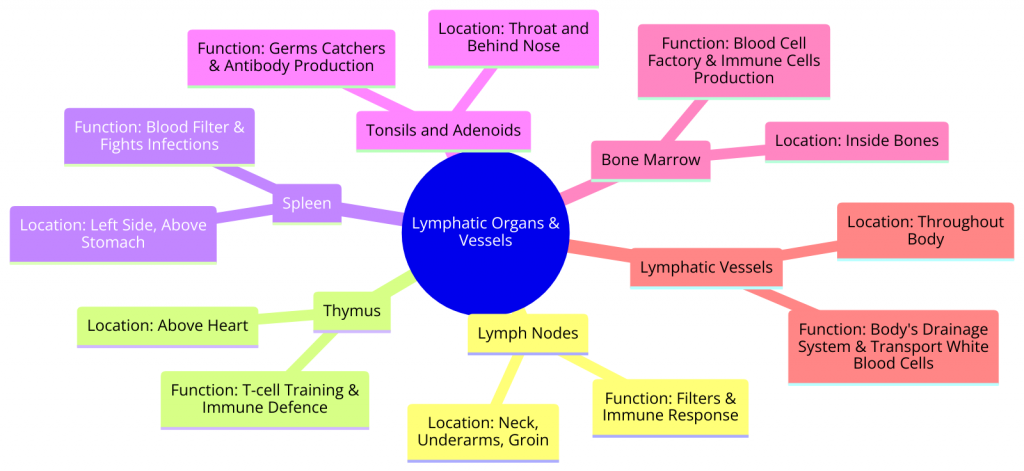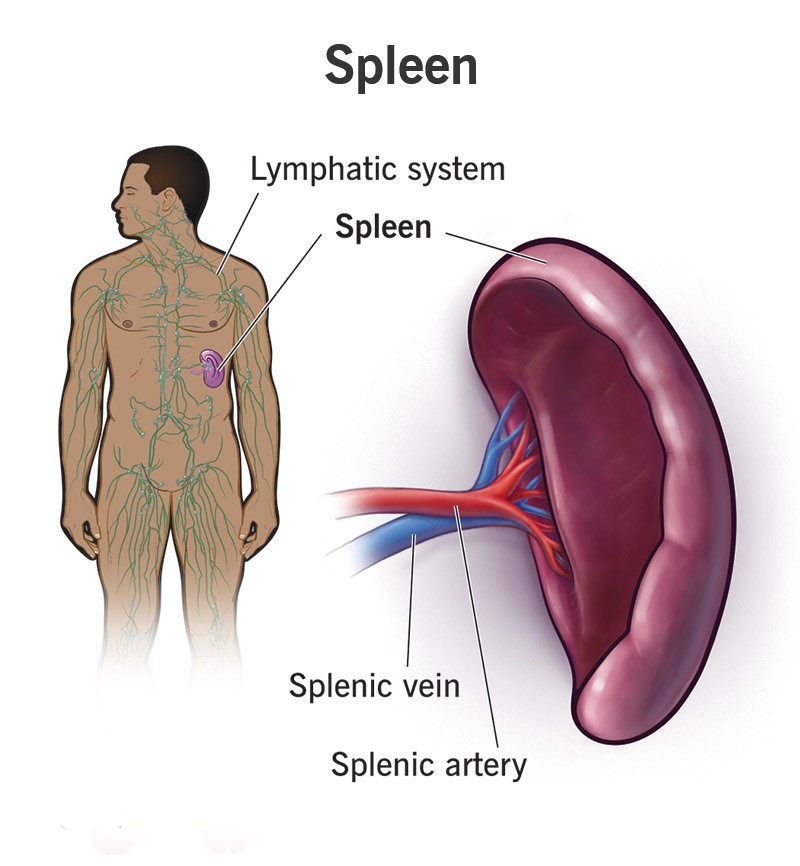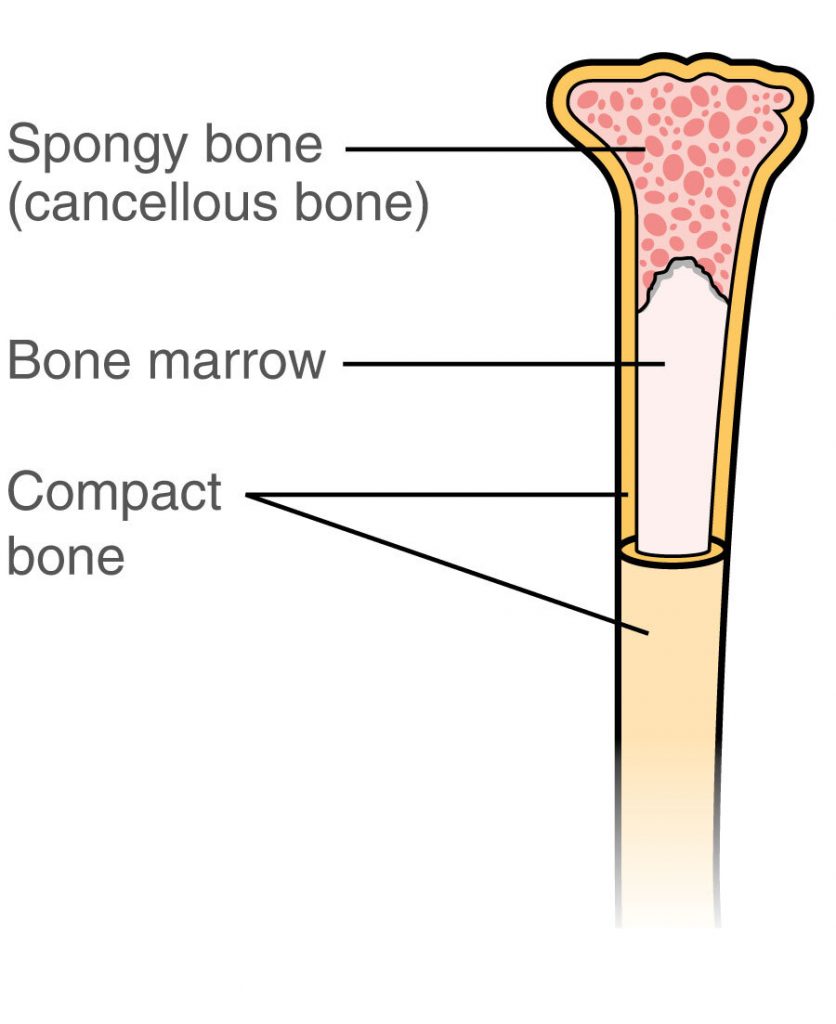The lymphatic system is like the body’s drainage and defence system rolled into one. It collects excess fluid from tissues, transports it back to the bloodstream, and helps the body fight off infections through the action of lymph nodes and the circulation of lymph. Understanding these components and their functions highlights the importance of the lymphatic system in maintaining fluid balance and protecting the body from disease.
Table of Contents
Key Organs of the Lymphatic System

The lymphatic system includes several organs that play vital roles in fluid balance and immune defence. Here’s a breakdown of these organs
1. Lymph Nodes-

Function-
- Filters- Lymph nodes act like tiny filters. They catch bad stuff like germs and waste in the lymph fluid, which is like the water that washes around your body’s cells.
- Immune Response- Inside lymph nodes, there are lots of white blood cells waiting to attack any germs they find. When they catch germs, they start fighting them, which can make the lymph nodes swell up. This is often why your neck might feel swollen when you’re sick.
Location-
- You have hundreds of lymph nodes all over your body, but they’re mainly in groups in your neck, underarms, and groin. These are places where your body can catch and fight germs before they spread further.
2. Thymus-

Function-
- T-cell Training Camp- The thymus is like a school for a special kind of white blood cell called T-cells. T-cells learn in the thymus how to tell the difference between your body’s own cells and outsiders, like germs or infected cells.
- Immune Defence- Once trained, T-cells leave the thymus ready to protect your body. They’re really good at spotting infections and can even remember germs they’ve fought before, so they’re quicker to fight them off next time.
Location-
- The thymus sits in your chest, just above your heart and behind your breastbone. It’s bigger when you’re a kid and gets smaller as you get older, but it’s super important for setting up your immune system when you’re young.
Also Check – 9 Important function of Lymphatic System
3. Spleen-

Function-
- Blood Filter- The spleen acts like a big filter for your blood. Its job is to catch and remove old or damaged red blood cells and platelets. This helps keep your blood clean and healthy.
- Fights Infections- It also helps your body fight infections, especially those caused by bacteria that can lead to diseases like pneumonia and meningitis. The spleen stores white blood cells and can release them into the blood to fight infections.
Location-
- The spleen is located on the left side of your body, just above your stomach and under your ribs. If you place your hand on the left side of your belly under your ribcage, your spleen is inside there.
Also Check – The New Era of the Lymphatic System: No Longer Secondary to the Blood Vascular System
4. Tonsils and Adenoids-

Function-
- Germs Catchers- Tonsils and adenoids are like the security guards at the entrance of your breathing passages. They catch germs, like viruses and bacteria, that you might breathe in through your mouth or nose.
- Antibody Production- They’re not just about catching germs; they also help make antibodies. Antibodies are like your body’s soldiers that remember and fight off germs they’ve seen before. This makes tonsils and adenoids an important part of your immune system’s defence team.
Location-
- Tonsils- These are located at the back of your throat. If you open your mouth wide and look in the mirror, you can usually see them on either side at the back of your throat.
- Adenoids- You can’t see these when you open your mouth because they’re higher up and behind your nose, near the back of your throat. They’re above the tonsils and behind the soft part of the roof of your mouth.
Also Check – How Lymph is Formed ?
5. Bone Marrow-

Function-
- Blood Cell Factory- Bone marrow is like the body’s factory for making blood cells. It produces red blood cells that carry oxygen, white blood cells that fight infections, and platelets that help your blood clot when you get a cut.
- Immune Cells- One important type of white blood cell it makes is lymphocytes. These cells are key players in your immune system, helping to protect you from germs.
Location-
- Inside Your Bones- Bone marrow is found in the middle of your bones. It’s especially abundant in the big bones like your hips and thighs. If you’ve ever seen the inside of a bone, like in a cooked chicken leg, the soft, spongy part in the centre is similar to bone marrow.
6. Lymphatic Vessels-

Function-
- Body’s Drainage System- Lymphatic vessels are part of your body’s way of collecting and getting rid of waste. They carry lymph, which is a fluid that picks up extra fluid, waste, and harmful germs from around your cells and brings it back to your bloodstream to be cleaned out.
- Transport White Blood Cells- These vessels also transport white blood cells, especially lymphocytes, throughout your body, so they can reach places where they’re needed to fight infections.
Location-
- All Over Your Body- Lymphatic vessels are spread throughout your entire body, much like blood vessels. They run alongside blood vessels, but instead of blood, they carry lymph. They start as tiny capillaries in your tissues and join to form larger vessels that eventually connect back to your bloodstream.
How These Organs Work Together
Let’s look at how the lymphatic system and the circulatory system team up to keep you healthy, especially when facing invaders like bacteria or viruses-
Maintaining Fluid Levels-
- Circulatory System- This includes your heart, blood, and blood vessels. It moves blood around your body.
- Lymphatic System- It collects extra fluid that leaks out from your blood vessels into your tissues and returns it to your bloodstream. Without this system, the fluid would build up and cause swelling.
Filtering Out Pathogens-
- Lymph Nodes– These are small, bean-shaped structures spread throughout your body. As lymph (the fluid in the lymphatic system) flows through these nodes, they act like filters catching germs such as bacteria and viruses.
- Spleen- This organ filters your blood, catching unwanted invaders and old or damaged blood cells.
Also Check – Human Circulatory System
Producing and Distributing White Blood Cells-
- Bone Marrow- It’s inside your bones and makes blood cells, including white blood cells that fight infections.
- Thymus- This is where T-cells (a type of white blood cell) grow up and learn to tell the difference between your body’s cells and invaders.
Triggering an Immune Response-
- When your body detects an invader, like a virus, the lymphatic system kicks into high gear.
- Lymph Nodes- They start producing more white blood cells to fight the invader. That’s why they might get swollen when you’re sick.
- Spleen and Thymus- These organs also step up. The spleen sends more white blood cells into your blood, and the thymus makes sure T-cells are ready to fight.
So, when you encounter a germ, your lymphatic system and circulatory system work together like a superhero team. The lymphatic system rounds up the invaders and sends out signals, and then it, along with the circulatory system, sends out the white blood cell “soldiers” to fight off the invaders, keeping you healthy.
